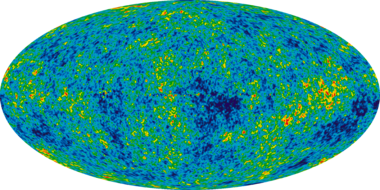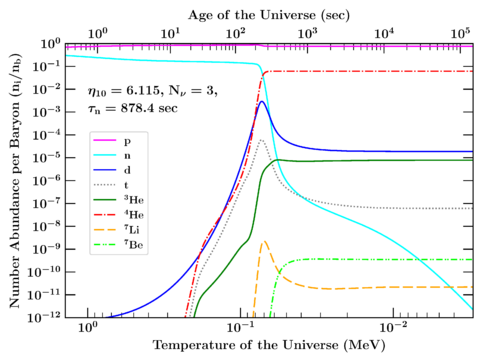Big Bang facts for kids
| Physical cosmology | ||||||||||||||
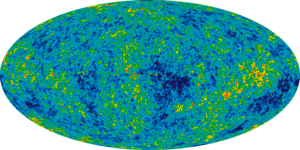 |
||||||||||||||
| Universe · Big Bang Age of the universe Timeline of the Big Bang Ultimate fate of the universe
|
||||||||||||||
The Big Bang is a leading physical theory that explains how our universe began and grew. It describes how the universe started from a super hot and super dense point and has been expanding ever since. This idea helps us understand many things we see in space, like why there are so many light elements (like hydrogen and helium), the faint glow of the cosmic microwave background (CMB) all around us, and how huge structures like galaxy clusters formed.
Scientists have a lot of evidence that strongly supports the Big Bang. Because of this, it's pretty much accepted by almost everyone in the scientific community. By carefully measuring how fast the universe is expanding, scientists estimate that the Big Bang happened about 13.8 billion years ago. This is considered the age of the universe.
If we imagine running the universe's expansion backward in time, using the laws of physics we know, it leads us to a time when the universe was incredibly hot and dense. Scientists don't yet have a complete theory to describe the very first moments of the Big Bang. As the universe expanded, it cooled down. This cooling allowed tiny subatomic particles to form, and later, these particles combined to make atoms. The first elements were mostly hydrogen, with some helium and a little lithium. Over vast amounts of time, these early elements clumped together because of gravity, helped by something mysterious called dark matter. This clumping led to the formation of the first stars and galaxys.
Recent observations show that the universe's expansion is actually speeding up! Scientists believe this is due to something called dark energy.
The idea of an expanding universe first came from physicist Alexander Friedmann in 1922, who used math to show it was possible. Then, in 1929, Edwin Hubble observed that galaxies are moving away from us, and the farther they are, the faster they move. This is now known as Hubble's law. Around the same time, in 1931, physicist Georges Lemaître (who was also a priest) suggested that the universe started from a "primeval atom" – a tiny, super-dense point. This was the beginning of the modern Big Bang idea. A big breakthrough happened in 1964 when the CMB was discovered. This discovery showed that the universe was indeed very hot and dense in the distant past, just as the Big Bang model predicted. By the late 1960s, most scientists agreed that the Big Bang was the best explanation for our universe, rather than the idea of a steady-state model where the universe always looked the same.
Even with all this understanding, there are still some puzzles the Big Bang model hasn't fully solved. These include why there's more matter than antimatter (baryon asymmetry), what dark matter is exactly, and where dark energy comes from.
Contents
Features of the Big Bang Model
The Big Bang model relies on a few main ideas:
- Laws of Physics are Universal: The rules of physics work the same everywhere in the universe.
- Cosmological Principle: On very large scales, the universe looks the same in all directions and from any location. It's smooth and even.
- Matter as a Perfect Fluid: The stuff in the universe can be thought of as a "perfect fluid" that flows without friction.
Scientists have tested these ideas. For example, observations show that the laws of physics have been very consistent throughout the universe's history. The idea that the universe is smooth and even on large scales has also been confirmed by looking at the CMB.
How the Universe Expands
The idea that the universe is smooth and even makes the math of general relativity simpler. This leads to equations (called Friedmann equations) that describe how the universe's shape and expansion change over time. The main thing that controls this is the amount of mass and energy in the universe. All the main features of the Big Bang model come from these results.
What the Universe is Made Of
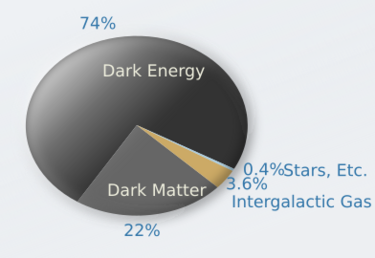
In the Big Bang model, the amount of mass and energy controls the universe's shape and how it changes. By combining what we see in space with the laws of thermodynamics (how heat works) and particle physics (how tiny particles behave), scientists have figured out what makes up the universe. In our universe today, the matter we can see – like stars, planets, and us – makes up less than 5% of everything. Dark matter makes up about 27%, and dark energy makes up the remaining 68%.
Cosmic Horizons
Because the universe has a limited age and light travels at a certain speed, there's a limit to how far back in time we can see. This is called the past horizon. Light from events beyond this horizon simply hasn't had enough time to reach us yet. Also, because space is expanding and distant objects are moving away faster, light we send out today might never reach very distant objects. This creates a future horizon, limiting what we can influence in the future.
Our understanding of the universe suggests there is a past horizon. Our view is also limited because the early universe was opaque, like a thick fog. If the universe keeps speeding up its expansion, there will also be a future horizon.
Timeline of the Universe
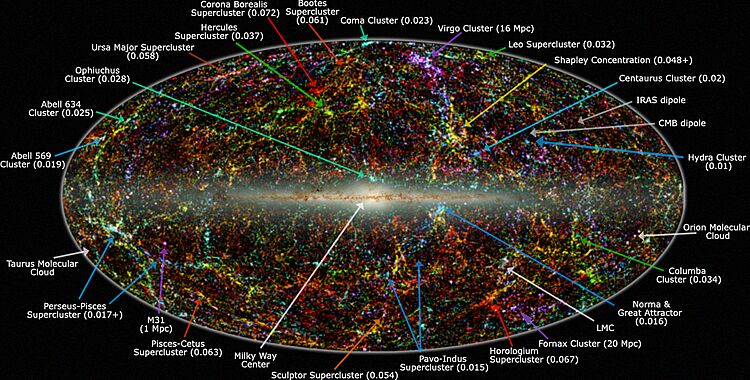
According to the Big Bang model, the universe started out extremely hot and compact. Since then, it has been expanding and cooling down.
The Very Beginning: A Hot, Dense Universe
Scientists can't tell us exactly what happened at the very moment of the Big Bang. If we use our current laws of physics, like general relativity, and go backward in time, it suggests the universe started from a point with infinite density and temperature. This is called a gravitational singularity. However, our current physics theories probably don't work in such extreme conditions. We need a theory of quantum gravity to understand this earliest time, called the Planck epoch, when the universe was incredibly hot (around 1032 Kelvin).
Even after the Planck epoch, there might have been new physics at play that we don't know about yet.
Inflation: A Super-Fast Growth Spurt
The very first moments of the Big Bang are still a bit of a mystery. In most models, the early universe was filled with incredibly high energy density, temperatures, and pressures. It was expanding and cooling very, very quickly.
Around 10−37 seconds after the Big Bang, a sudden change caused a period called cosmic inflation. During inflation, the universe grew incredibly fast, much faster than the speed of light (this doesn't break any rules because space itself was expanding, not objects moving through space). This rapid growth helped make the universe very flat and smooth, just as we observe it today. Tiny quantum fluctuations (random jitters) that happened during inflation got stretched out to huge sizes. These stretched fluctuations became the "seeds" for all the large structures we see in the universe today, like galaxies and galaxy clusters.
Inflation stopped around 10−33 to 10−32 seconds after the Big Bang. After inflation, the universe "reheated," creating a hot soup of quarks and gluons, along with all other elementary particles. At these super high temperatures, particles and antiparticles were constantly being created and destroyed. For some unknown reason, a tiny bit more matter was created than antimatter (about one part in 30 million). This small difference is why our universe is made of matter today, and not just energy from matter-antimatter annihilation. This process is called baryogenesis.
Cooling Down and Forming Particles
The universe kept expanding, becoming less dense and cooler. As it cooled, the fundamental forces of physics (like the electromagnetic force and the weak nuclear force) took on their current forms.
Around 10−6 seconds after the Big Bang, quarks and gluons combined to form baryons, such as protons and neutrons. Because there was a tiny excess of quarks, there was also a small excess of protons and neutrons. The temperature was no longer high enough to create new proton-antiproton or neutron-antineutron pairs. Most of the antimatter then annihilated with matter, leaving behind only a small fraction of the original matter particles. A similar process happened for electrons and positrons around 1 second after the Big Bang. After these annihilations, the remaining protons, neutrons, and electrons were no longer moving at super-fast speeds, and the universe's energy was mostly in the form of photons (light particles).
A few minutes after the Big Bang, when the universe was about a billion kelvin (super hot!) and as dense as Earth's atmosphere, neutrons combined with protons. This formed the first deuterium and helium nuclei in a process called Big Bang nucleosynthesis (BBN). Most protons remained as simple hydrogen nuclei.
Building Atoms and Becoming Clear
As the universe cooled further, the matter in it started to have more gravitational pull than the radiation (photons). This happened around 50,000 years after the Big Bang.
Then, at about 380,000 years, the universe cooled enough for electrons to combine with nuclei to form neutral atoms (mostly hydrogen). This event is called recombination. Before this, the universe was like a thick fog because photons (light particles) kept bumping into free electrons. But once atoms formed, the photons could travel freely. This made the universe transparent, and these photons are what we now see as the cosmic microwave background.
How Galaxies and Stars Formed
After the universe became transparent, regions that were slightly denser than others started to pull in more matter due to gravity. These denser regions grew even more, forming gas clouds, then stars, galaxies, and eventually the huge structures we see in space today, like galaxy clusters.
Scientists believe that a mysterious substance called cold dark matter (CDM) played a big role in this. The best measurements suggest that CDM makes up about 23% of the universe's matter/energy, while the normal matter we see is only about 4.6%.
The Universe Speeds Up: Dark Energy

Recent observations of distant exploding stars (called Type Ia supernovae) and the CMB tell us that the universe today is dominated by something called dark energy. This mysterious energy seems to be spread evenly throughout all of space. Observations suggest that dark energy makes up about 73% of the universe's total energy density.
When the universe was very young, everything was closer together, and gravity was stronger, slowing down the expansion. But after billions of years, as the universe expanded, the density of matter decreased. This allowed dark energy to become more dominant, causing the universe's expansion to start speeding up.
Scientists don't fully understand what dark energy is or how it works. It's one of the biggest mysteries in physics.
Amazing Evidence for the Big Bang
The Big Bang model explains many things we observe in the universe. These include:
- The amounts of light elements (like hydrogen and helium).
- The cosmic microwave background (CMB).
- The large-scale structure of galaxies.
- Hubble's law, which describes the expansion of the universe.
These are often called the "four pillars" of the Big Bang model.
Expanding Universe: Hubble's Law
When scientists look at distant galaxies and quasars, they see that the light coming from them is "redshifted." This means the light waves have been stretched to longer, redder wavelengths. This happens because the galaxies are moving away from us. The farther away a galaxy is, the more its light is redshifted, meaning it's moving away faster. This relationship is called Hubble's law:

Where:
 is how fast the galaxy is moving away.
is how fast the galaxy is moving away. is its distance from us.
is its distance from us. is Hubble's constant, which tells us the rate of expansion today.
is Hubble's constant, which tells us the rate of expansion today.
Hubble's law shows that the universe is expanding everywhere. This expansion was predicted by scientists like Friedmann and Lemaître before Hubble even made his observations. It's a key part of the Big Bang model.
Cosmic Microwave Background: Echoes of the Big Bang
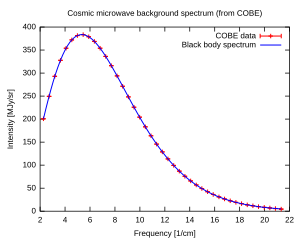
In 1964, two scientists, Arno Penzias and Robert Wilson, accidentally discovered a faint, uniform glow of microwave radiation coming from all directions in space. This was a huge discovery! It was exactly what other scientists (like Alpher, Herman, and Gamow) had predicted would be leftover heat from the Big Bang.
This radiation is the "afterglow" of the Big Bang. When the universe was very young (about 380,000 years old), it was a hot, dense fog of charged particles. Light couldn't travel far without bumping into these particles. But as the universe cooled and neutral atoms formed, the fog cleared, and light could travel freely. This light has been traveling ever since, getting stretched and cooled by the universe's expansion. Today, it's a very cold glow, about 2.725 degrees above absolute zero.
In 1989, NASA launched the COBE satellite, which confirmed that the CMB was indeed a perfect "blackbody" spectrum (meaning it came from a hot, uniform source) and measured its temperature very precisely. Then, in 1992, COBE found tiny temperature differences (called anisotropies) in the CMB across the sky. These tiny differences, about one part in 100,000, are incredibly important because they are the "seeds" from which all the structures in the universe (like galaxies and galaxy clusters) grew.
Later missions, like the Wilkinson Microwave Anisotropy Probe (WMAP) and the Planck space probe, have given us even more detailed maps of the CMB, helping us understand the universe's early history even better.
Light Elements: The Universe's First Ingredients
The Big Bang model can predict the amounts of the lightest elements created in the early universe: helium-4 (4He), helium-3 (3He), deuterium (2H), and lithium-7 (7Li). These predictions depend on just one factor: the ratio of photons (light particles) to baryons (protons and neutrons).
The amounts of these elements that we measure in the universe today match very well with what the Big Bang model predicts. For example, the universe is about 25% helium-4 by mass, which is a key prediction of the Big Bang. This agreement is strong evidence for the Big Bang, as no other theory can explain why these light elements exist in these specific amounts.
Galaxies Evolving: Seeing the Past
When we look at distant galaxies, we are actually seeing them as they were billions of years ago, because their light has taken so long to reach us. Observations of how galaxies look and are spread out in space fit perfectly with the Big Bang model.
Scientists believe that the first quasars (very bright centers of early galaxies) and galaxies formed within a billion years after the Big Bang. Since then, larger structures like galaxy clusters and superclusters have continued to form.
Distant galaxies (seen from the early universe) look very different from nearby galaxies (seen more recently). This shows that galaxies have changed and evolved over time, which supports the Big Bang model and goes against the idea of a "steady-state" universe that never changes.
Big Questions We Still Have
Even though the Big Bang model is very successful, there are still some big mysteries and problems that scientists are working to solve.
Why More Matter Than Antimatter?
Scientists don't fully understand why our universe is made almost entirely of matter, with very little antimatter. It's thought that in the very early, hot universe, there were equal amounts of matter and antimatter. When they met, they would have destroyed each other, leaving only light. But clearly, there's a lot of matter left!
There must have been a tiny imbalance, where slightly more matter was created than antimatter (perhaps one extra matter particle for every 10 billion pairs that annihilated). This process is called baryogenesis. While our current understanding of particle physics allows for this to happen, it doesn't explain why the imbalance was exactly what it was to create the universe we see today.
The Mystery of Dark Energy
As mentioned earlier, observations show that the universe's expansion is speeding up. To explain this, scientists propose the existence of "dark energy." This mysterious energy seems to have a strange "negative pressure" that pushes space apart.
Dark energy helps solve several problems. For example, measurements of the CMB show that the universe is very "flat" in its overall shape. For a flat universe, the total amount of mass and energy needs to be a specific "critical density." But when we measure the normal matter and dark matter, it only adds up to about 30% of that critical density. Dark energy makes up the missing 70%, bringing the total to the critical density needed for a flat universe.
The exact nature of dark energy is one of the biggest puzzles in physics. Is it a constant energy of empty space (like Einstein's cosmological constant) or something else entirely?
The Puzzle of Dark Matter

In the 1970s and 1980s, scientists noticed that there wasn't enough visible matter in galaxies and galaxy clusters to explain how strongly they were held together by gravity. This led to the idea of "dark matter." Dark matter doesn't emit light or interact with normal matter in ways we can easily detect, but it has gravity. Scientists believe that up to 90% of the matter in the universe is dark matter.
Evidence for dark matter comes from many observations: how galaxies rotate, how galaxy clusters move, how light bends around massive objects (gravitational lensing), and the tiny variations in the CMB. While we have strong indirect evidence for dark matter's gravitational effects, no dark matter particles have been directly observed in laboratories yet. Scientists are actively searching for them.
The Horizon and Flatness Problems
- Horizon Problem: The CMB looks incredibly smooth and uniform across the entire sky. But if the universe has a finite age, and light has a finite speed, then regions of the universe that are very far apart shouldn't have had enough time to "talk" to each other and become the same temperature. How did they become so uniform?
- Flatness Problem: Observations suggest that the universe is very "flat" in its overall shape. The problem is that any tiny deviation from flatness in the early universe would have grown huge over billions of years. So, why is it still so incredibly flat today?
These problems are usually solved by the idea of cosmic inflation. Inflation suggests that the universe expanded incredibly fast in its earliest moments. This super-fast expansion would have stretched out any small region to a huge size, making it look flat and uniform, and allowing distant parts to have been in contact before inflation began.
Common Misunderstandings About the Big Bang
The Big Bang model is sometimes misunderstood. Here are a few common misconceptions:
- It's Not About the "Origin" of Everything: The Big Bang model doesn't explain how energy, time, and space first appeared. Instead, it describes how our universe developed from an extremely dense and hot starting state. It's about the evolution of the universe, not its absolute beginning.
- It Wasn't an Explosion in Space: The Big Bang wasn't like a bomb exploding in an empty room. Instead, it was the expansion of space itself, carrying everything with it. There was no "outside" for it to expand into.
- It Doesn't Mean Galaxies Move Faster Than Light: When we say distant galaxies are moving away faster than the speed of light due to Hubble's law, it doesn't mean they are breaking the rules of relativity. This is because it's space itself that's expanding, not the galaxies moving through space at those speeds.
What's Next for Our Universe?
Based on what we know now, scientists can make educated guesses about the future of the universe, but the farther into the future we look, the more speculative it becomes.
Before we discovered dark energy, scientists thought the universe would either:
- Collapse (Big Crunch): If there was enough matter, gravity would eventually pull everything back together, ending in a hot, dense state similar to the Big Bang.
- Expand Forever and Freeze (Big Freeze/Heat Death): If there wasn't enough matter, the expansion would slow down but never stop. Stars would eventually burn out, and the universe would become cold, dark, and empty.
However, modern observations show that the universe's expansion is accelerating due to dark energy. This means that more and more of the universe we can see today will eventually move beyond our reach, becoming invisible to us.
The most accepted model, the Lambda-CDM (ΛCDM) model, suggests that only systems held together by gravity (like galaxies) will remain intact. But even these will eventually experience a "heat death" as the universe expands and cools forever. Some more extreme ideas, like "phantom dark energy," even suggest a "Big Rip," where the expansion becomes so strong that it tears apart galaxies, stars, planets, and even atoms themselves!
Concept History
Where Did the Name "Big Bang" Come From?
The term "Big Bang" was actually coined by English astronomer Fred Hoyle during a BBC Radio broadcast in 1949. He was talking about the idea that the universe started from "one big bang" in the past.
It's often thought that Hoyle, who preferred a different idea called the "steady-state" universe, used the term to make fun of the Big Bang theory. However, Hoyle himself denied this, saying it was just a vivid way to describe the idea.
Early Ideas About an Expanding Universe
[[Multiple image |direction=vertical |align=right |width=400|image1=XDF-scale.jpg|image2=The Hubble eXtreme Deep Field.jpg |image3=XDF-separated.jpg|caption1=XDF size compared to the size of the Moon. The small box near the Moon shows the area of the XDF, which contains thousands of galaxies! |caption2=XDF (2012) view – every tiny speck of light is a galaxy. Some of these are almost as old as the universe itself! |caption3=XDF image shows galaxies at different ages: fully grown galaxies in the foreground, and younger, blazing protogalaxies from billions of years ago. |header=Hubble eXtreme Deep Field (XDF) – a deep look into the universe's past.]] The ideas behind the Big Bang developed from observations and theories about the universe. In 1912, Vesto Slipher noticed that most "spiral nebulae" (which we now know are other galaxies) were moving away from Earth.
Ten years later, in 1922, Alexander Friedmann, a Russian mathematician, used Einstein's equations to show that the universe could be expanding, rather than being static (unchanging) as Albert Einstein thought at the time.
In 1924, American astronomer Edwin Hubble proved that these "nebulae" were indeed separate galaxies far outside our own Milky Way. By 1929, Hubble discovered a clear link: the farther away a galaxy was, the faster it was moving away from us. This became known as Hubble's law.
Independently, in 1927, Georges Lemaître, a Belgian physicist and priest, also came up with Friedmann's equations. He suggested that the galaxies moving away from us meant the universe was expanding. In 1931, Lemaître took this idea further, proposing that if you rewind the expansion, the universe must have started from a single, tiny point – a "primeval atom" – where space and time themselves began.
In the 1920s and 1930s, many scientists preferred the idea of an eternal, unchanging universe. Some even worried that the idea of a "beginning" sounded too much like religious creation stories. However, Lemaître argued that if the universe started from a single point, the concepts of space and time would only make sense after that point had expanded.
After World War II, two main ideas competed:
- Fred Hoyle's Steady-State Model: This idea suggested that new matter was constantly being created as the universe expanded, so the universe always looked the same.
- Lemaître's Expanding Universe Theory: This idea was further developed by George Gamow and his colleagues, Ralph Alpher and Robert Herman. They used it to explain how the chemical elements in the universe formed and even predicted the existence of the cosmic background radiation.
The discovery and confirmation of the CMB in 1964 was the turning point. It strongly supported the Big Bang model and showed that the steady-state model was likely incorrect.
From the 1970s to the 1990s, scientists worked on understanding the Big Bang universe better and solving its problems. In 1981, Alan Guth introduced the idea of "inflation" – a period of super-fast expansion in the early universe – which helped explain some of the Big Bang's puzzles.
Since the late 1990s, with better telescopes and data from satellites like COBE, the Hubble Space Telescope, and WMAP, scientists have made huge progress. We now have very precise measurements of many Big Bang parameters and have even made the surprising discovery that the universe's expansion is speeding up!
See also
 In Spanish: Big Bang para niños
In Spanish: Big Bang para niños
- Anthropic principle
- Big Bounce
- Cold Big Bang
- Cosmic Calendar
- Cosmogony
- Eureka: A Prose Poem, a Big Bang speculation
- Heat death of the universe. Also known as the Big Chill and the Big Freeze
- Non-standard cosmology
- Shape of the universe




